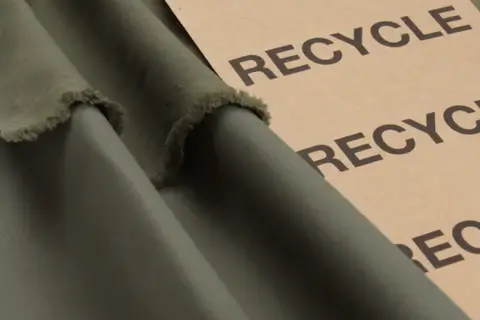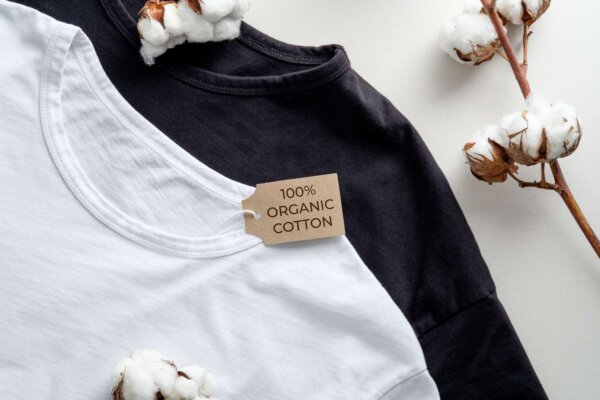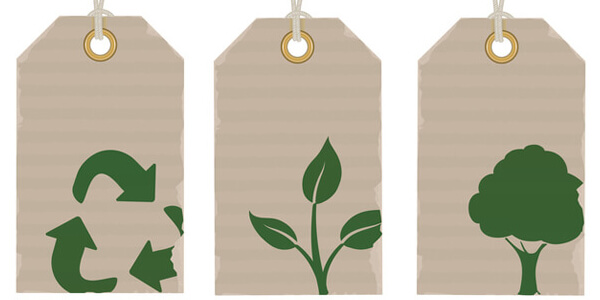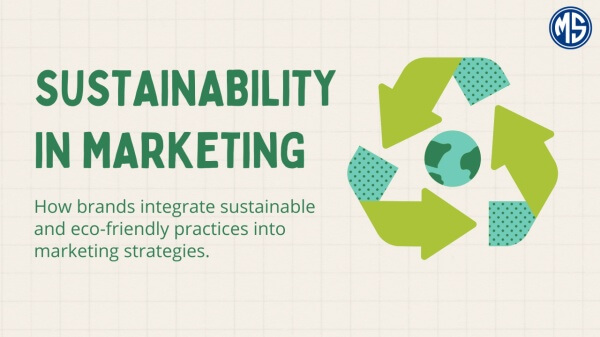Das Business Case für nachhaltige Aktivkleidung: Erfüllung der Verbrauchernachfrage & Verbesserung des Markenwerts?
Umweltbedenken treiben die Kaufentscheidungen der Verbraucher zunehmend vor. Marken, die das Nachhaltigkeitsrisiko ignorieren, der Marktanteil für umweltbewusstere Wettbewerber verlieren, insbesondere in der Kategorie Activewear, in der die Verbindung zu Natur und Wellness von größter Bedeutung ist.
Nachhaltige Aktivkleidung ist sowohl eine Umwelt imperativ als auch eine Geschäftsmöglichkeit. 67% der Verbraucher berücksichtigen Nachhaltigkeit beim Kauf von Aktivkleidung, und 73% sind bereit, mehr für nachhaltige Produkte zu bezahlen. Marken, die recycelte Materialien, organische Baumwolle oder biologisch abbaubare Stoffe enthalten, können Premium -Preise beherbergen und gleichzeitig bewusste Verbraucher anziehen.

At HAVING, we've embraced sustainability in our activewear manufacturing, offering recycled polyester options, organic cotton blends, and eco-friendly packaging solutions. Our experience has shown that sustainability isn't just good for the planet—it's good for business. Let me share what we've learned about the compelling business case for sustainable activewear.
Warum wird Nachhaltigkeit zu einem Marktgebot?
Verbraucherpräferenzen verändern sich dramatisch in Richtung nachhaltiger Optionen. Marken, die dieses Trendrisiko nicht erkennen, wenn sie als umweltbewusste Alternativen den Marktanteil erfassen.
67% der weltweiten Verbraucher geben an, dass sie beim Kauf von Aktivkleidung Nachhaltigkeit berücksichtigen, und dieser Prozentsatz steigt auf 73% bei Millennials. In der Kategorie Fitness and Wellness äußern 78% der Verbraucher besorgt über die Umweltauswirkungen ihrer Einkäufe, was Nachhaltigkeit zu einem wichtigen Unterscheidungsmerkmal bei Kaufentscheidungen macht.

When we first started manufacturing activewear at HAVING, sustainability was considered a niche selling point. Today, it's become a mainstream expectation, particularly in this category. Here's why sustainability has become a market imperative:
Verschiebung der Verbraucherwerte
Jüngste Marktforschung zeigt dramatische Veränderungen der Verbraucherprioritäten:
| Verbrauchertrend | Prozentsatz | Geschäftsimplikation |
|---|---|---|
| Bereit, mehr für nachhaltige Produkte zu bezahlen | 73% | Gelegenheit zur Premium -Preisen |
| Betrachten Sie die Umwelteinflüsse wichtig bei Kaufentscheidungen | 67% | Nachhaltigkeit als Wettbewerbsvorteil |
| Suchen Sie aktiv Marken mit starken Umweltwerten | 58% | Gelegenheit zur Markentreue |
| Haben Marken basierend auf Umweltproblemen gewechselt | 35% | Risiko eines Kundenverlusts, wenn nicht nachhaltig |
Generationenunterschiede
Nachhaltigkeitspräferenzen variieren nach Generation erheblich:
- Gen Z (18-24): 83% glauben, dass Unternehmen Umweltfragen angehen sollten
- Millennials (25-40): 73% sagen, dass Umweltprobleme ihre Einkaufsentscheidungen beeinflussen
- Gen X (41-56): 60% bereit, mehr für nachhaltige Produkte zu bezahlen
- Babyboomer (57-75): 52% berücksichtigen Nachhaltigkeit bei Kaufentscheidungen
Bei jüngeren Generationen, die den Hauptmarkt für Activewear repräsentieren, sind ihre stärkeren Nachhaltigkeitspräferenzen für diese Kategorie besonders relevant.
Activewear-spezifische Bedenken
Die Aktivkleidungsindustrie steht vor einer besonderen Prüfung:
- Synthetische Stoffe wie Polyester und Nylon sind auf Erdölbasis und nicht biologisch abbaubar
- Produktionsprozesse können Wasser und chemischintensiv sein
- Schnelle Modeansätze haben zu übermäßigen Abfällen geführt
- Verbraucher sehen zunehmend eine Trennung zwischen Wellness-fokussierten Produkten und umweltschädlichen Praktiken
Diese Bedenken haben eine bedeutende Marktchance für Marken geschaffen, die sich authentisch mit Nachhaltigkeit befassen und gleichzeitig Leistung und Stil beibehalten können.
Eine umfassende Übersicht über den Activewear -Markt und die Verbrauchertrends finden Sie in unserer detaillierten Analyse: Die Aktivkleidung verstehen & Yoga Wear Market: Trends, Demografie & Möglichkeiten für B2B -Käufer.
Was sind die finanziellen Vorteile einer nachhaltigen Aktivkleidung?
Viele Unternehmen zögern, aufgrund von Bedenken hinsichtlich Kosten und Renditen in Nachhaltigkeit in Nachhaltigkeit zu investieren. Das Verständnis des vollständigen Business Case hilft zu rechtfertigen, diese Investitionen zu rechtfertigen.
Die Kapitalrendite für nachhaltige Aktivkleidung erfolgt über mehrere Kanäle: Premium-Preisgestaltungspotential (15 bis 30% höhere Preispunkte), gesteigerte Kundenbindung (27% höhere Aufbewahrungsraten für nachhaltige Marken), verbessertes Markenreputation, Vorteile des Einzelhandels-Placements und ein reduziertes Risiko für künftige Aufnahmeprobleme.

At HAVING, we've seen firsthand how sustainability investments deliver tangible business returns. Here's the comprehensive business case:
Finanzielle Vorteile
Prämienpreispotential
Marktforschung zeigt, dass Verbraucher mehr für nachhaltige Produkte zahlen werden:
- 73% zahlen mindestens 10% mehr für nachhaltige Optionen
- 32% zahlen 25% oder mehr für Produkte mit starken Umweltanweisungen
- In Activewear befehlen nachhaltige Optionen 15 bis 30% Preisprämien
Erhöhtes Verkaufsvolumen
Nachhaltigkeitsantriebe für Kaufentscheidungen:
- 67% der Verbraucher kaufen mit größerer Wahrscheinlichkeit Produkte, die eindeutig als umweltfreundlich gekennzeichnet sind
- Nachhaltige Activwear-Marken sehen in der Regel 15-25% höhere Conversion-Raten
- Einzelhändler melden 10-20% höhere Verkaufsraten für nachhaltige Activewear-Produkte
Verbesserte Kundenbindung
Nachhaltigkeit baut stärkere Kundenbeziehungen auf:
- Marken mit starken Nachhaltigkeitsberechtigungen genießen 27% höhere Kundenbindung
- 41% der Verbraucher empfehlen eher nachhaltige Marken für Freunde
- Der lebenslange Kundenwert steigt für nachhaltige Produkte um ca. 22%
Markenwertverbesserung
Reputationsnutzen
Nachhaltigkeit stärkt die allgemeine Markenwahrnehmung:
- 64% der Verbraucher (und 72% der Millennials) haben ein positiveres Image von Marken mit nachgewiesenen Nachhaltigkeitsverpflichtungen
- Die Berichterstattung über die Medien ist 2,5 -facher für Marken mit authentischen Nachhaltigkeitsgeschichten wahrscheinlicher
- Social -Media -Engagement -Raten sind für nachhaltige Produktinhalte um 35% höher
Wettbewerbsdifferenzierung
Auf dem zunehmend überfüllten Activewear -Markt:
- Nachhaltigkeit schafft eine sinnvolle Differenzierung über die grundlegende Funktionalität hinaus
- 52% der Verbraucher berücksichtigen Umweltauswirkungen bei der Auswahl zwischen ähnlichen Activewear -Produkten
- Nachhaltigkeitsanmeldeinformationen helfen zu vermeiden, dass der Druck des Rohstoffpreises zu vermeiden ist
Vorteile des Einzelhandelsplatzierungsvorteils
Große Einzelhändler priorisieren zunehmend nachhaltige Produkte:
- Viele Einzelhändler haben Nachhaltigkeitsanforderungen für neue Anbieter festgelegt
- Premium -Einzelhandelsplatzierung wird häufig nachhaltigen Optionen zugewiesen
- Einige Einzelhändler bieten Marketingunterstützung speziell für nachhaltige Produkte an
Risikominderung
Vorschriftenregulierung
Proaktive Nachhaltigkeitsannahme reduziert zukünftige Risiken:
- Umweltvorschriften werden weltweit strengerer
- Eine frühzeitige Einführung verhindert später kostspielige erzwungene Änderungen
- Einige Märkte setzen erweiterte Gesetze zur Verantwortung des Herstellers um
Verbraucherschutzschutz
Nachhaltigkeit schützt vor negativer Werbung:
- Marken ohne Umweltverpflichtungen stehen vor einer zunehmenden Prüfung
- Social Media verstärkt Umweltbedenken schnell
- Anschuldigungen von Greenwashing können erhebliche Markenschäden verursachen
Ausführliche Informationen zu Preisstrategien und Gewinnmargen für nachhaltige Aktivkleidung finden Sie in unserer Analyse: Maximieren Sie Ihren ROI: Activewear & Yoga tragen Großhandelspreise, Einzelhandelsmargen & Rentabilitätsanalyse.
Welche nachhaltigen Materialoptionen stehen für Activewear zur Verfügung?
Viele Unternehmen sind sich der Auswahl an nachhaltigen Materialien nicht bewusst, die jetzt für Aktivkleidung erhältlich sind. Das Verständnis dieser Optionen ist für Entscheidungen mit fundierten Produktentwicklungen von entscheidender Bedeutung.
Zu den nachhaltigen Materialien für Aktivkleidung gehören recyceltes Polyester (hergestellt aus Plastikflaschen nach dem Verbrauch), recyceltes Nylon (häufig aus Fischereinetzen und Teppichabfällen), organischer Baumwolle (ohne schädliche Pestizide gezüchtet) und innovative natürliche Leistungsstoffe wie Lyocell auf Eukalyptusbasis. Jedes bietet unterschiedliche Leistungsmerkmale und Nachhaltigkeitsvorteile.

At HAVING, we've developed activewear using various sustainable materials. Here's our assessment of the key options:
Recycelte synthetische Materialien
Recycelter Polyester
Umweltvorteile:
- Leitet Plastikflaschen von Deponien und Ozeanen ab
- Benötigt 30-50% weniger Energie als Virgin Polyester
- Reduziert die Abhängigkeit von Erdöl
- Erzeugt 54% weniger Kohlenstoffemissionen als Virgin Polyester
Leistungseigenschaften:
- Nahezu identische Leistung mit Virgin Polyester
- Hervorragende Feuchtigkeitsdickung
- Gute Haltbarkeit und Farbhaftigkeit
- Schnelltrocknungseigenschaften
Geschäftliche Überlegungen:
- 10-15% Kostenprämie über Virgin Polyester
- Starke Marketinggeschichte (Flaschen-zu-Fabric)
- In verschiedenen Qualitäten weit verbreitet
- Kann über GRS zertifiziert werden (globaler recycelter Standard)
Recycelter Nylon
Umweltvorteile:
- Oft aus Fischereien, Teppichabfällen oder Vorverschiebungsabfällen hergestellt
- Reduziert Abfall in Ozeanen und Deponien
- Benötigt 80% weniger Wasser als Virgin Nylon
- Produziert 90% weniger Co₂ als Virgin Nylon
Leistungseigenschaften:
- Vergleichbar mit Virgin Nylon in den meisten Eigenschaften
- Ausgezeichnete Dehnung und Genesung
- Weiches Handgefühl
- Langlebig und abriebfest
Geschäftliche Überlegungen:
- 15-25% Kostenprämie über Virgin Nylon
- Begrenzte, aber wachsende Verfügbarkeit
- Besonders überzeugende Geschichte für Ocean Waste Nylon
- Kann über GRS zertifiziert werden
Natürliche und halbsynthetische Materialien
Bio -Baumwolle
Umweltvorteile:
- Ohne synthetische Pestizide oder Düngemittel gewachsen
- Verwendet 88% weniger Wasser als herkömmliche Baumwolle
- Fördert die Bodengesundheit und die biologische Vielfalt
- Reduziert die Exposition der Landwirte gegenüber schädlichen Chemikalien
Leistungseigenschaften:
- Natürliche Atmungsaktivität und Komfort
- Weiches Handgefühl
- Hypoallergene Eigenschaften
- Am besten für Aktivitäten mit niedriger bis moderatem Intensität
Geschäftliche Überlegungen:
- 20-30% Kostenprämie gegenüber herkömmlichen Baumwolle
- Erfordert das Mischen mit Elastane zur Stretch
- Kann über GOTS zertifiziert werden (globaler organischer Textilstandard)
- Starke Anziehungskraft für umweltbewusste Verbraucher
Lyocell/Tencel
Umweltvorteile:
- Hergestellt aus nachhaltig geerntetem Holzzellstoff
- Produktionsprozess mit geschlossenem Schleifen recycelt 99% der Lösungsmittel
- Biologisch abbaubares Material
- Benötigt weniger Wasser als Baumwolle
Leistungseigenschaften:
- Natürliches Feuchtigkeitsmanagement
- Seidige glatte Textur
- Atmungsaktiv und temperaturregulierend
- Hemmt natürlich das Bakterienwachstum
Geschäftliche Überlegungen:
- 15-25% Kostenprämie gegenüber herkömmlichen Stoffen
- Oft mit anderen Fasern zur Leistung gemischt
- Wachsende Verfügbarkeit und Innovation
- Luxus -Positionierungspotential
Materialvergleichskarte
| Material | Kostenprämie | Leistungsniveau | Beste für |
|---|---|---|---|
| Recycelter Polyester | 10-15% | Exzellent | Aktivitäten mit hoher Intensität, Feuchtigkeitsmanagement |
| Recycelter Nylon | 15-25% | Exzellent | Yoga, Studioaktivitäten, Komprimierungsstücke |
| Bio -Baumwollmischungen | 20-30% | Gut | Aktivitäten mit geringer Auswirkung, empfindliche Haut |
| Lyocell/Tencel | 15-25% | Sehr gut | Premium -Positionierung, Temperaturregulation |
Detaillierte Informationen zu Activewear -Materialien und -Technologie finden Sie in unserem umfassenden Leitfaden: Aktivkleidung & Yoga Wear -Technologie & Materials: A Buyer's Guide to Performance Fabrics, Construction & Haltbarkeit.
Wie implementieren Sie eine nachhaltige Activwear -Strategie?
Viele Unternehmen haben effektiv mit der Umsetzung von Nachhaltigkeit zu kämpfen. Ohne einen strategischen Ansatz können Anstrengungen fragmentiert, ineffektiv oder anfällig für Anschuldigungen von Green waschen.
Die Implementierung einer erfolgreichen Strategie für nachhaltige Aktivkleidung erfordert einen phasedigen Ansatz: Durchführung einer Nachhaltigkeitsbewertung der aktuellen Produkte, der Ermittlung von Vorrangsbereichen für Verbesserungen, Entwicklung klarer Nachhaltigkeitsziele, Auswahl geeigneter Materialien und Prozesse, der Erlangung relevanter Zertifizierungen und der Erstellung eines authentischen Marketings, das Greenwashing vermeidet.

At HAVING, we help our partners develop and implement effective sustainability strategies. Here's our recommended approach:
Phase 1: Bewertung und Zieleinstellung
Verstehen Sie zunächst Ihre aktuellen Umweltauswirkungen:
- Produktlebenszyklusbewertung: Bewerten Sie die Umweltauswirkungen über den gesamten Produktlebenszyklus
- Materialanalyse: Bewerten Sie aktuelle Materialien für Nachhaltigkeitsprobleme
- Lieferkette Mapping: Identifizieren Sie wichtige Umwelt -Hotspots in Ihrer Lieferkette
- Konkurrent Benchmarking: Verstehen Sie, was andere auf dem Markt tun
Setzen Sie klare, messbare Nachhaltigkeitsziele:
- Materialziele: z. B. "50% recycelter Inhalt bis 2024"
- Kohlenstoffreduktion: z. B. "30% Reduktion des CO2 -Fußabdrucks bis 2025"
- Abfallreduzierung: z. B. "Null Abfall, um bis 2023 aus der Produktion von Produktion abzubauen"
- Wasserschutz: z. B. "40% Reduktion des Wasserverbrauchs bis 2024"
Phase 2: Implementierungsstrategie
Entwickeln Sie einen phasedigen Implementierungsplan:
Materialsubstitution
- Beginnen Sie mit Kernprodukten: Beginnen Sie mit Ihren Bestsellern, um eine maximale Wirkung zu erzielen
- Hybridansatz: Betrachten Sie Mischungen nachhaltiger und konventioneller Materialien als Übergang
- Leistungstests: Stellen Sie sicher, dass nachhaltige Alternativen die Leistungsanforderungen entsprechen
- Kostenanalyse: Berechnen Sie den ROI einschließlich der potenziellen Preisprämie -Chancen
Verbesserungen der Lieferkette
- Auswahl der Fertigungspartner: Wählen Sie Partner mit Nachhaltigkeitsanmeldeinformationen
- Prozessoptimierung: Identifizieren Sie die Möglichkeiten zur Reduzierung von Wasser und Energie
- Transporteffizienz: Optimieren Sie die Versandmethoden und die Verpackung
- Abfallreduzierung: Implementieren Sie Schnitteffizienz und Schrottrecyclingprogramme
Zertifizierungsstrategie
- Identifizieren Sie relevante Zertifizierungen: Wählen Sie Zertifizierungen aus, die Ihren Ansprüchen entsprechen
- Dokumentationssysteme entwickeln: Erstellen Sie Prozesse, um Nachhaltigkeitsansprüche zu verfolgen und zu überprüfen
- Überprüfung von Drittanbietern: Unabhängige Überprüfung der Nachhaltigkeitsansprüche einbeziehen
- Kontinuierliche Verbesserung: Planen Sie die laufende Zertifizierungswartung und -erweiterung
Phase 3: Marketing und Kommunikation
Entwickeln Sie authentische Nachhaltigkeitsnachrichten:
- Spezifisch sein: Verwenden Sie eher konkrete Fakten als vage Ansprüche
- Transparent sein: Bestätigen Sie, dass die Bereiche noch verbessert werden
- Lehrreich sein: Helfen Sie den Verbrauchern, die Auswirkungen ihrer Entscheidungen zu verstehen
- Vermeiden Sie Greenwashing: Don't overstate environmental benefits
Effektive Kommunikationskanäle:
- Produktkennzeichnung: Klare Nachhaltigkeitsinformationen zu Tags und Verpackungen
- Website -Inhalt: Dedizierter Nachhaltigkeitsabschnitt mit detaillierten Informationen
- Social Media: Regelmäßige Updates zu Nachhaltigkeitsinitiativen und Fortschritt
- Personalausbildung: Stellen Sie sicher, dass die Teammitglieder die Nachhaltigkeitsfunktionen genau erklären können
ROI -Berechnungsgerüst
Betrachten Sie bei der Bewertung von Nachhaltigkeitsinvestitionen diesen Rahmen:
| Anlagekategorie | Typische Kostenerhöhung | Potenzielle Rendite | Rückzahlungsperiode |
|---|---|---|---|
| Recycelte Materialien | 10-15% | 15-25% Preisprämie | Unmittelbar bis 6 Monate |
| Organische Materialien | 20-30% | 20-30% Preisprämie | Unmittelbar bis 6 Monate |
| Nachhaltige Verpackung | 5-15% | 5-10% Umbauverbesserung | 6-12 Monate |
| Nachhaltigkeitszertifizierung | Jährlich 2.000 bis 10.000 US-Dollar | 10-20% erhöhte die Platzierung des Einzelhändlers | 6-18 Monate |
Anhand der Anleitung zur Entwicklung Ihrer eigenen nachhaltigen Activewear -Linie finden Sie in unserer detaillierten Ressource: Ihre Marke, Ihr Produkt: Der komplette Leitfaden für die Aktivbekleidung für Private Label (OEM/ODM) & Yoga Wear Manufacturing.
Abschluss
Das Business Case für nachhaltige Aktivkleidung ist überzeugend und facettenreich. Nach der wachsenden Nachfrage der Verbraucher nach umweltverträglichen Produkten bieten Nachhaltigkeitsinitiativen unmittelbare geschäftliche Vorteile durch Prämienpreismöglichkeiten, erhöhte Kundenbindung, verbesserten Markenwert und Risikominderung.
At HAVING, we're committed to supporting our partners in developing truly sustainable activewear that delivers both environmental and business benefits. By embracing sustainability as a core business strategy rather than a marketing afterthought, brands can position themselves for long-term success in this rapidly evolving market.
Eine umfassende Übersicht über die gesamte Kategorie Activewear, einschließlich Markttrends und Geschäftsmöglichkeiten, besuchen Sie unsere Ultimativer B2B -Leitfaden zur Beschaffung & Verkaufen activewear & Yoga -Verschleiß.
Häufig gestellte Fragen (FAQ)
What's the most important sustainability feature for activewear consumers?
Während die Präferenzen je nach Segment variieren, zeigen Untersuchungen, dass recycelten Gehalt (insbesondere recyceltes Polyester aus Plastikflaschen) das allgemein geschätzte Nachhaltigkeitsmerkmal ist, gefolgt von reduziertem Wasserverbrauch und organischen Materialien.
Wie viel mehr sind Verbraucher bereit, für nachhaltige Aktivkleidung zu bezahlen?
Die Marktforschung zeigt, dass 73% der Verbraucher mindestens 10% für nachhaltige Optionen zahlen werden, während 32% für Produkte mit starken Umweltvoraussetzungen Prämien von 25% oder höher zahlen.
Welche Nachhaltigkeitszertifizierungen sind für Activewear am wertvollsten?
GRS (Global Recycled Standard) ist am wertvollsten für Recycling -Inhaltsansprüche, GOTS (Global Organic Textile Standard) für organische Materialien und Bluesign® für die allgemeine umweltverträgliche Produktion. Oeko-TEX Standard 100 bietet eine wesentliche Glaubwürdigkeit der Sicherheit.
Wie können kleine Marken mit großen Unternehmen mit Nachhaltigkeit konkurrieren?
Kleine Marken können häufig schneller und authentische Nachhaltigkeitsinitiativen implementieren als große Unternehmen. Konzentrieren Sie sich auf transparente Kommunikation, spezifische Umweltvorteile und die Herstellung echter Verbindungen zu Nachhaltigkeitsverbrauchern.
Ist es besser, sich auf nachhaltige Materialien oder nachhaltige Fertigung zu konzentrieren?
Beide sind wichtig, aber nachhaltige Materialien haben in der Regel eine sofortige Sichtbarkeit der Verbraucher und die Marketing -Auswirkungen. Ein umfassender Ansatz für Materialien und Herstellungsprozesse schafft jedoch die stärkste Nachhaltigkeitspositionierung.
Wie vermeide ich Greenwashing Anschuldigungen bei der Vermarktung nachhaltiger Aktivkleidung?
Seien Sie spezifisch in Bezug auf Umweltansprüche, liefern Sie Beweise und Zertifizierungen, um sie zu sichern, die Bereiche, die noch verbessert werden, und konzentrieren Sie sich eher auf Fortschritte als auf Perfektion. Transparenz über Ihre Nachhaltigkeitsreise baut Glaubwürdigkeit auf.
Holen Sie sich ein kostenloses Angebot für Ihre Activewear -Projekte
